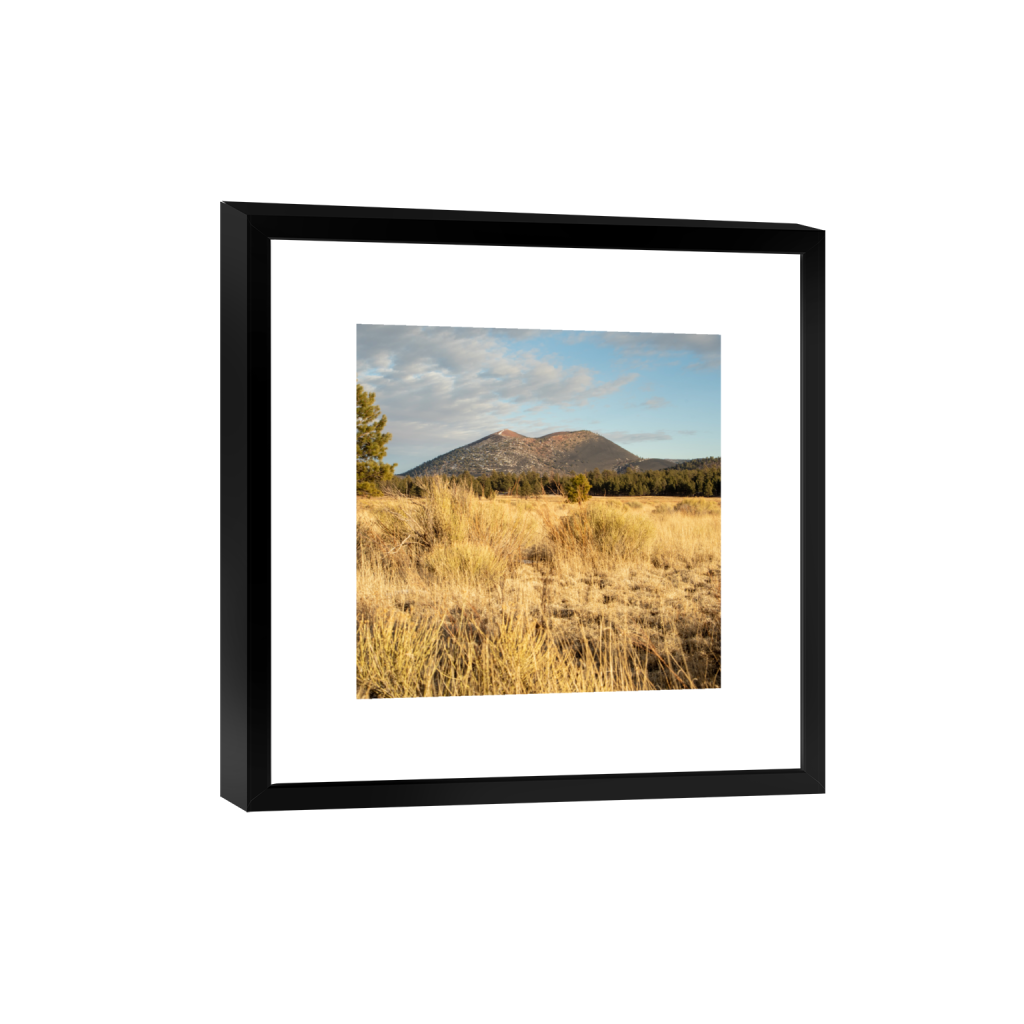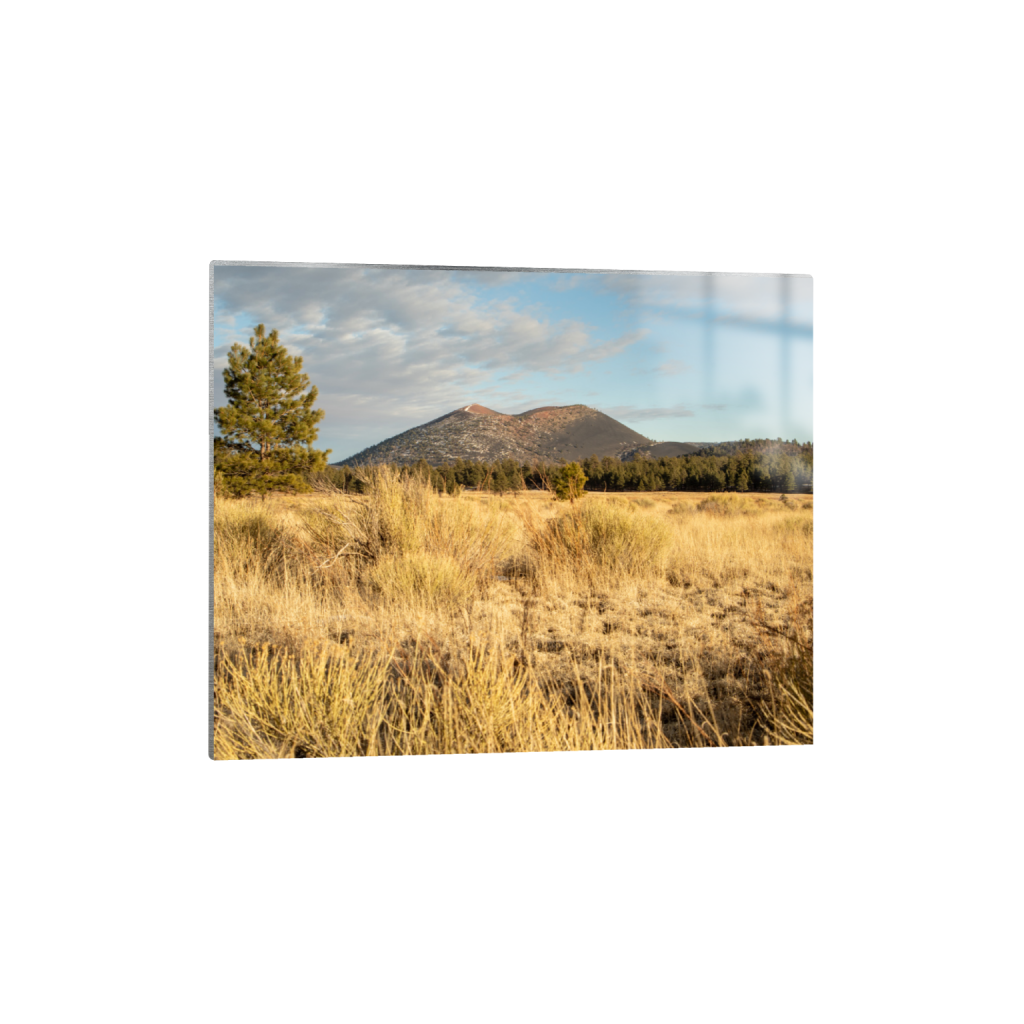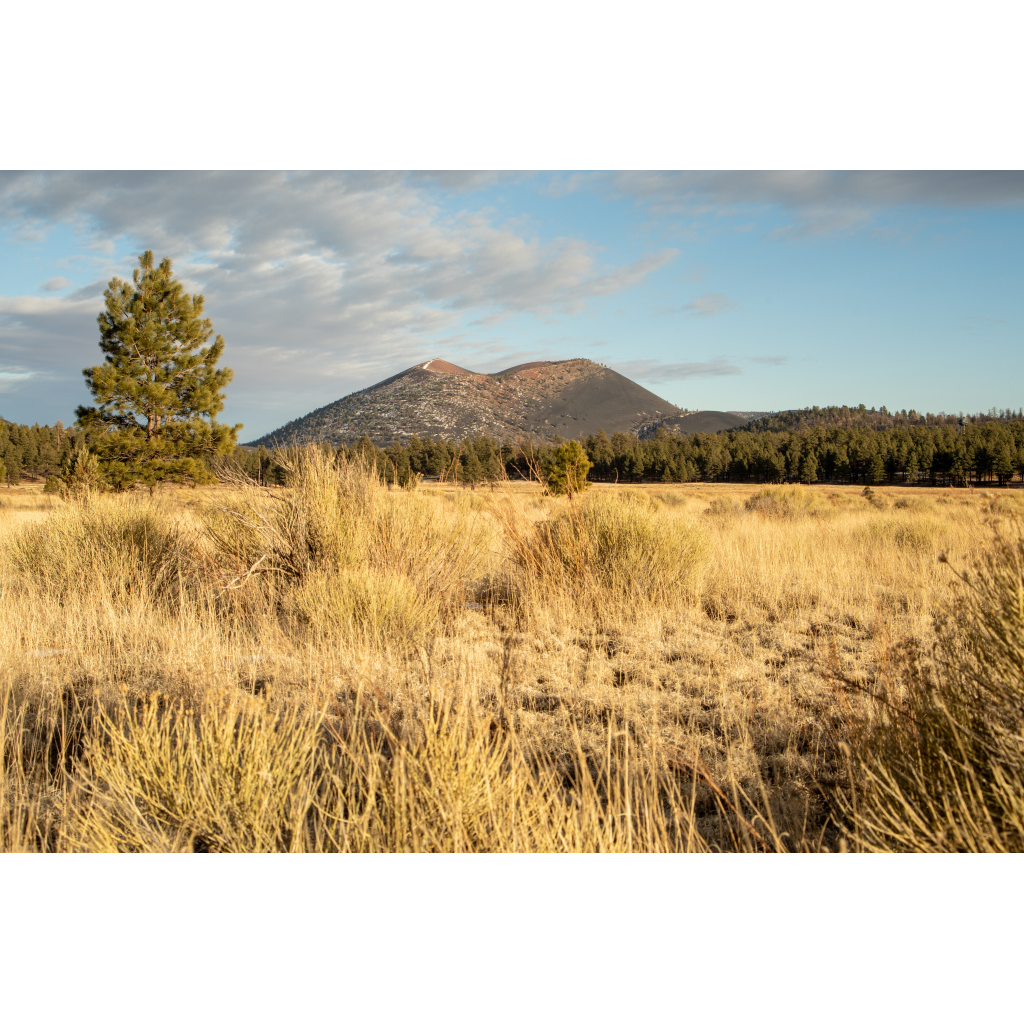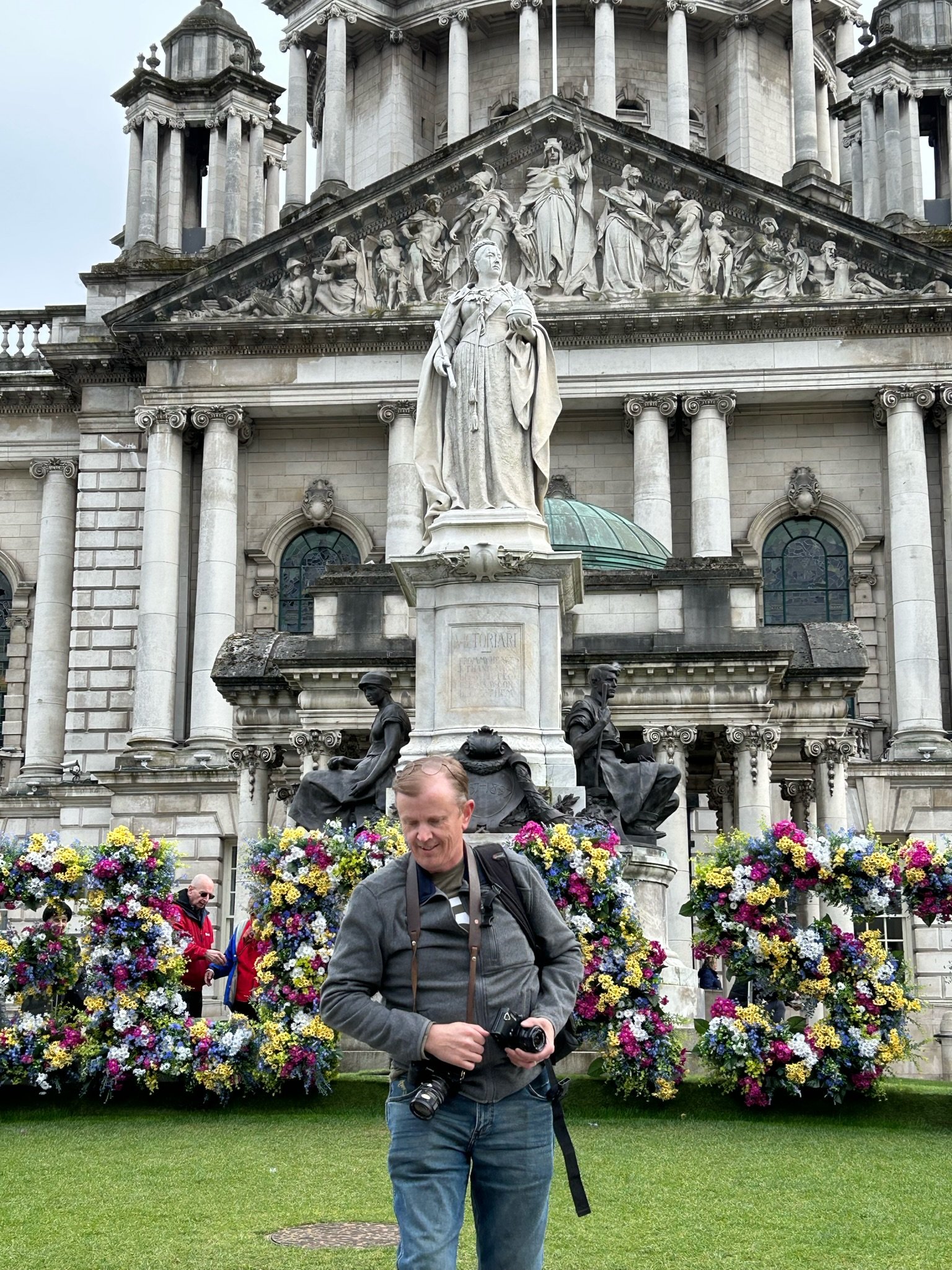Sunset Crater Volcano
Photographing Sunset Crater Volcano is like capturing the vivid palette of a master artist at work. As the sun dips below the horizon, the cinder cone transforms into a canvas of deep oranges and purples, with shadows dancing across the rugged terrain and a dusting of snow. The contrasting textures of the black volcanic rock against the overcast sky creates a stunning visual symphony, challenging the limits of perception and inviting a playful exploration of line and form. Each click of the shutter is an exhilarating reminder that beauty can thrive in the starkest of landscapes, leaving us to ponder the wonders of nature, even when sight becomes a fleeting memory.
On Sunday, Deana and I eagerly headed up to the charming town of Flagstaff to do some shopping for her. Flagstaff is truly an amazing place that we both thoroughly enjoy exploring together. There is so much to see and do around Flagstaff, from quaint shops to scenic views. After our adventurous shopping excursions, we decided to venture over to the Majestic Sunset Crater Volcano, a stunning location where life continues to spring up vibrantly amongst the rugged cinders of a volcanic eruption that occurred way back in 1085 A.D. According to Wikipedia:
The date of the eruptions that formed the 340-meter-high cone (1,120 ft) was initially derived from tree-ring dates, suggesting the eruption began between the growing seasons of AD 1064–1065.[7] However, more recent geologic and archaeological evidence places the eruption around AD 1085.[8] The largest vent of the eruption, Sunset Crater itself, was the source of the Bonito and Kana-a lava flows that extended about 2.5 kilometers (1.6 mi) northwest and 9.6 kilometers (6 mi) northeast, respectively. Additional vents along a 10-kilometer-long fissure (6.2 mi) extending southeast produced small spatter ramparts and a 6.4-kilometer-long lava flow (4 mi) to the east. The Sunset Crater eruption peaked at VEI 4 (Sub-Plinian), produced a total 0.52 km3 of ejecta,[9] had an eruption column between 20-30km tall[10] and produced a blanket of ash and lapilli covering an area of more than 2,100 square kilometers (810 sq mi), which forced the temporary abandonment of settlements of the local Sinagua people.
As we approached the volcano, my jaw dropped. The view from the open fields in front of the park were picturesque. There was a light dusting of snow atop the crater. We had hoped for more snow, but it was still breathtaking. I got out my now trust Sony A7Cii and Soligor 35*70mm f2.5 lens and went to work. Deana yelled at me at one point, because I had disappeared in the golden grasses. I get very excited about taking photographs, like a sniper crawling around on the ground, looking for the right vantage point. But, I am looking for just the right perspective and composition.
We continued on into the expansive park, fully embracing the captivating pastoral scenes as well as the more somber, charred remnants of burned trees and winding lava flows that told a story of their own. I found myself contemplating what it must have been like when this mighty volcano erupted in its fiery glory. The sunset, while somewhat mediocre at best, did not dampen our spirits; we made the most of it and joyfully headed home after a few hours of wandering amongst the rugged cinders and ancient lava flows. I could not recommend this enchanting place enough. There is truly so much to do in this vibrant area and an abundance of incredible sights to behold, each more mesmerizing than the last.
Living as the Wife of a Blind Photographer
It was April 22, 2023 when I married my best friend and the love of my life. The man who was blind in his left eye told me that one day he would be completely blind, but I did not mind, for I knew he loved me for me and would do anything to care for me and keep me safe. I even knew that he was losing the hearing in his right ear, and that would progress as well due to the illness called septo-optic dysplasia. I knew that my future as a wife would be different than the future of most wives, even with my own diagnosis of dry macular degeneration. But I didn’t fully understand how soon everything would start to change. After all, who can truly understand their future until they’re living in it?
We immensely enjoyed our honeymoon, taking photographs of beautiful Ireland with b&w film cameras and iPhones. I may have stolen his Pentax K1000 while we were in the Emerald Isle, but I also loved using my Olympus Trip 35 and Canon AE1 Program to photograph the awesomeness that is the home of some of our ancestors. I often photographed my new husband taking photographs because he is in a different world when he is behind a camera. He sees beauty where others do not, and captures it in a way that only the resultant photographs can explain. One of my favorite photographs is of him, stepping away from having just captured Belfast’s city hall building, with a smile only seen when he is in his element. I worry not because he has a smile reserved for me, one that lights up my days and warms my nights. But the smile he reserves for when he feels he got the best possible shot is completely different; unaltered joy with a hint of mischief. It’s like he knows a secret that only he will ever know.
January 23rd of 2024 rolls around and we visit a local eye doctor, one to whom a good friend had referred me. It was probably the most important eye exam of our lives, as it changed so much. I learned more about the macular degeneration from which I suffer and my husband, well, his world changed upside down. His eyesight was worse than I thought — he had been hiding how bad it was getting, but I think he was hiding it from himself as well. He was told to stop driving due to his very limited peripheral vision. And I also don’t think he knows how badly he missed so many of the letters he read on his eye exam. The E’s and N’s and P’s and O’s were so different than how he had perceived them. So we left the exams with prescriptions for new eyeglasses and a hurt in our hearts for my husband’s need to give up driving and what that meant for his career. I was strong that day, only to cry in secret knowing that one day my husband’s use of the camera would be over; he would no longer see the beauty in the world that people often overlook. And I, well, I would need to continue with biannual eye exams to track the progress of my vision. I couldn’t even think of that, however, as I knew I one day would be married to a blind photographer.
Prior to our eye exams, my husband had been talking about pinhole photography and mentioned to me how he would love to use a pinhole camera. He even showed me one he would like, not knowing that I would purchase it for him as an early Valentine’s Day gift. I wanted to ensure he had access to such a camera while he could use it — the purchase was important, yet tearful. Needless to say, he loved the gift and proceeded to use the new capturer of beauty immediately. But the truth remained that his eyesight would continue to fail, and it has.
Due to my increasing struggle with allergies and disdain for humidity, he suggested leaving South Carolina and moving back to my home state of Arizona — to Northern Arizona in particular. Neither of us wanted to endure the summers in Phoenix metro, after all. So we made the trek across the US, several days stuck in a little, red Subaru with three dogs in the back seat. It was like traveling with three toddlers that were only welcome at specific Airbnb’s — if you know, you know. But we had a blast because we were able to take some time and I thoroughly enjoyed seeing these places I knew so well through his lone-functioning eye. The photographs we took are memories I will cherish always. He got to meet some of my cousins in Oklahoma, while we stayed a few extra days there for the fourth of July. It gave me a wonderful break from the drive, as there is only ever one driver in our family now. Then we ventured onward with him visualizing the southwest for the first time, shocked by its awesomeness. His excitement was heartwarming. I got to share some of my favorite places with my love.
Today we are living in Payson, Arizona and we get out to see something new in the state every chance we get. I need to share so many places with him before he can no longer see them. It hurts my heart beyond belief that one day he will not be able to see the majesty of this world. However, his positive attitude and desire to live everyday to its fullest, taking photographs wherever he goes, is inspiring. I cannot imagine living with his diagnosis, but, then again, I am in denial of the suffering that may lay in the future in regards to my eyes. Macular degeneration is no joke. But today I see more clearly than ever, knowing that time on this earth is limited; we never know when we will not be able to see the wonder of God’s creation any longer. He and I will make the best of this situation, taking photographs as much as possible, until we are completely unable to engage in his favorite activity. I will do my best to be the supportive wife while he purchases cameras, fixed them, uses them, and sells some of them only to start the process again. And, hopefully, he will inspire others to see through the lens of a film camera, while I hope to inspire people to take those memories, print them and put them into scrapbooks to be enjoyed later.
by Deana Davis, wife of the blind photographer.































































